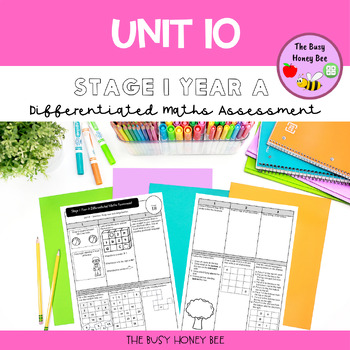Stage 1 Year A Differentiated Maths Assessment Unit 10
- Zip
- Microsoft OneDrive
Also included in
- This EDITABLE Differentiated Maths Assessment Bundle has been compiled in a Microsoft Word Document and Google Sheets making it easier for you to adapt, change or use as is to meet the needs of your students and the context of your school. This assessment assesses the NSW Year 1 outcomes and conceptPrice $13.00Original Price $14.50Save $1.50
Description
This EDITABLE differentiated assessment has been created to assess the NSW Maths Syllabus 2022 syllabus outcomes. Concepts assessed have been covered in the NSW Maths Sample Stage 1 Year A Unit 10 – Sometimes things move and change location.
Attribution is given to © State of New South Wales (Department of Education), 2021 and licensed under the Creative Commons Attribution 4.0 International License.
This assessment has been compiled by The Busy Honey Bee 2023 and is not endorsed by the DoE.
I have created this assessment in Microsoft Word so that it can be completely edited. This is so that you can adjust if needed to meet the needs of your students or school. If the differentiation option doesn't work for your students, then I have included a base assessment underneath (see preview) that only asks the 'at stage' questions.
How to use this differentiated Maths assessment:
There are 3 columns that indicate a point system. The first column acquires 1 point for the correct answer. Second column 2 points and the third column 3 points.
The first column indicates below stage, middle column is at stage level and the third column, working above stage outcomes. This will give you a clear indicator of where your students sit. Each question in each of the columns are aimed at that level. For example, if this was a stage 2 year 3 assessment, then the first column would be year 2 level questions, the middle would be year 3 questions and the third column would be a range of year 4 and year 5 questions. The reason it is in the year 5 range is because the third column is designed for above stage outcomes. If the student is in year 3, then if they were to answer year 4 questions, they would still be working at stage level because year 3 and 4 are both working towards achieving stage 2 outcomes.
The student can attempt as many parts of the questions as possible. Encourage the students to answer the section of the question they feel they can, but also encourage them to challenge themselves. Students will only receive points for the question answered correctly with the highest value. For example, if a student attempts the first and second column and answers both correctly, they would get points for the highest valued column, being the second column scoring 2 points.
As you may have noticed, the overall assessment score is the total amount of points in the second column and not the third column. This is because students are not expected to be achieving above stage outcomes, but through this assessment are given the opportunity to demonstrate their ability to do so. Therefore, it would be unfair to be given a mark for the total overall maths assessment.
By marking it out of a total of points that can be acquired in the middle column, any score above this mark will indicate to you that the student is achieving beyond stage outcomes. You could also choose to work out the average of their score.
There is also a section for students to really show you what they are capable of through open-ended maths questions. These questions are marked through teacher judgment rather than a point system. You will identify if the student is working at below, at or above stage level using the evidence they have given you. Again, really encourage the students to provide as much information as possible so that you can make an accurate judgment.
With the open-ended number section, students can show you absolutely everything they know about that concept. The answers are limitless and provide students with an opportunity to connect their learning in a variety of ways.
Customer Tips:
How to get TPT credit to use on future purchases:
Go to your "My Purchases" page. Beside each purchase you will see a "Provide Feedback" button. On your "My Purchases" page, you will see a list of products you have purchased and a link to provide feedback. Remember, you earn TPT credits to use to purchase other products. These credits are just like cash! So please leave a feedback review, it would be much appreciated :)
I ♥ Followers!
Be the first to know about store discounts, free products, and product launches! Just click the green “Follow Me” star under my store name on this page or click the “Follow Me” star under The Busy Honey Bee.
Terms of use:
- This purchase is for you and your classroom. Duplication for an entire school or an entire school system is strictly forbidden. Additional copies must be purchased for each classroom use.
- This product can be altered and built upon to suit the needs of your classroom, students, teaching and learning within the context of your school but cannot be resold as your own product.
- No refunds will be issued under any circumstances. This is a digital product and cannot be returned. Please make sure you read the description carefully to ensure that you know exactly what you are buying. Thank you.



